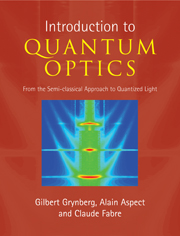Book contents
- Frontmatter
- Contents
- Foreword
- Preface
- Acknowledgements
- Part I Semi-classical description of matterlight interaction
- Part II Quantum description of light and its interaction with matter
- 4 Quantization of free radiation
- Complement 4A: Example of the classical Hamiltonian formalism: charged particle in an electromagnetic field
- Complement 4B: Momentum and angular momentum of radiation
- Complement 4C: Photons in modes other than travelling plane waves
- 5 Free quantum radiation
- Complement 5A: Squeezed states of light: the reduction of quantum fluctuations
- Complement 5B: One-photon wave packet
- Complement 5C: Polarization-entangled photons and violation of Bell's inequalities
- Complement 5D: Entangled two-mode states
- Complement 5E: Quantum information
- 6 Interaction of an atom with the quantized electromagnetic field
- Complement 6A: Hamiltonian formalism for interacting fields and charges
- Complement 6B: Cavity quantum electrodynamics
- Complement 6C: Polarization-entangled photon pairs emitted in an atomic radiative cascade
- Part III Applying both approaches
- Index
Complement 5A: Squeezed states of light: the reduction of quantum fluctuations
Published online by Cambridge University Press: 05 August 2012
- Frontmatter
- Contents
- Foreword
- Preface
- Acknowledgements
- Part I Semi-classical description of matterlight interaction
- Part II Quantum description of light and its interaction with matter
- 4 Quantization of free radiation
- Complement 4A: Example of the classical Hamiltonian formalism: charged particle in an electromagnetic field
- Complement 4B: Momentum and angular momentum of radiation
- Complement 4C: Photons in modes other than travelling plane waves
- 5 Free quantum radiation
- Complement 5A: Squeezed states of light: the reduction of quantum fluctuations
- Complement 5B: One-photon wave packet
- Complement 5C: Polarization-entangled photons and violation of Bell's inequalities
- Complement 5D: Entangled two-mode states
- Complement 5E: Quantum information
- 6 Interaction of an atom with the quantized electromagnetic field
- Complement 6A: Hamiltonian formalism for interacting fields and charges
- Complement 6B: Cavity quantum electrodynamics
- Complement 6C: Polarization-entangled photon pairs emitted in an atomic radiative cascade
- Part III Applying both approaches
- Index
Summary
We showed in Section 5.2 of the present chapter that according to quantum theory the value of the electric field of an electromagnetic wave could not be predicted to arbitrarily high precision, this being a consequence of the uncertainty relation satisfied by the two quadrature components of the field (Equation 5.32), which imposed a finite limit on the product of their variances. This limit is more than an abstract theoretical limit; it is often the overriding factor determining the resolution of high-precision optical measurements. In such situations measurements by photodetectors on the field exhibit uncontrollable fluctuations of quantum origin known as quantum noise. Fortunately, as we shall show in this complement, it is possible to overcome this by using non-classical states of the radiation field, namely the squeezed states, provided measurements are made of a single one of a pair of conjugate field variables. A field mode prepared in such a state exhibits reduced quantum noise in one of the variables at the expense of increased noise in the other, so that the uncertainty relation involving their variances is still satisfied. The potential of such states for increasing the obtainable precision of optical measurements is self-evident. However, the practical realization of the potential benefits requires delicate experimental techniques that we describe only briefly here.
- Type
- Chapter
- Information
- Introduction to Quantum OpticsFrom the Semi-classical Approach to Quantized Light, pp. 387 - 397Publisher: Cambridge University PressPrint publication year: 2010



